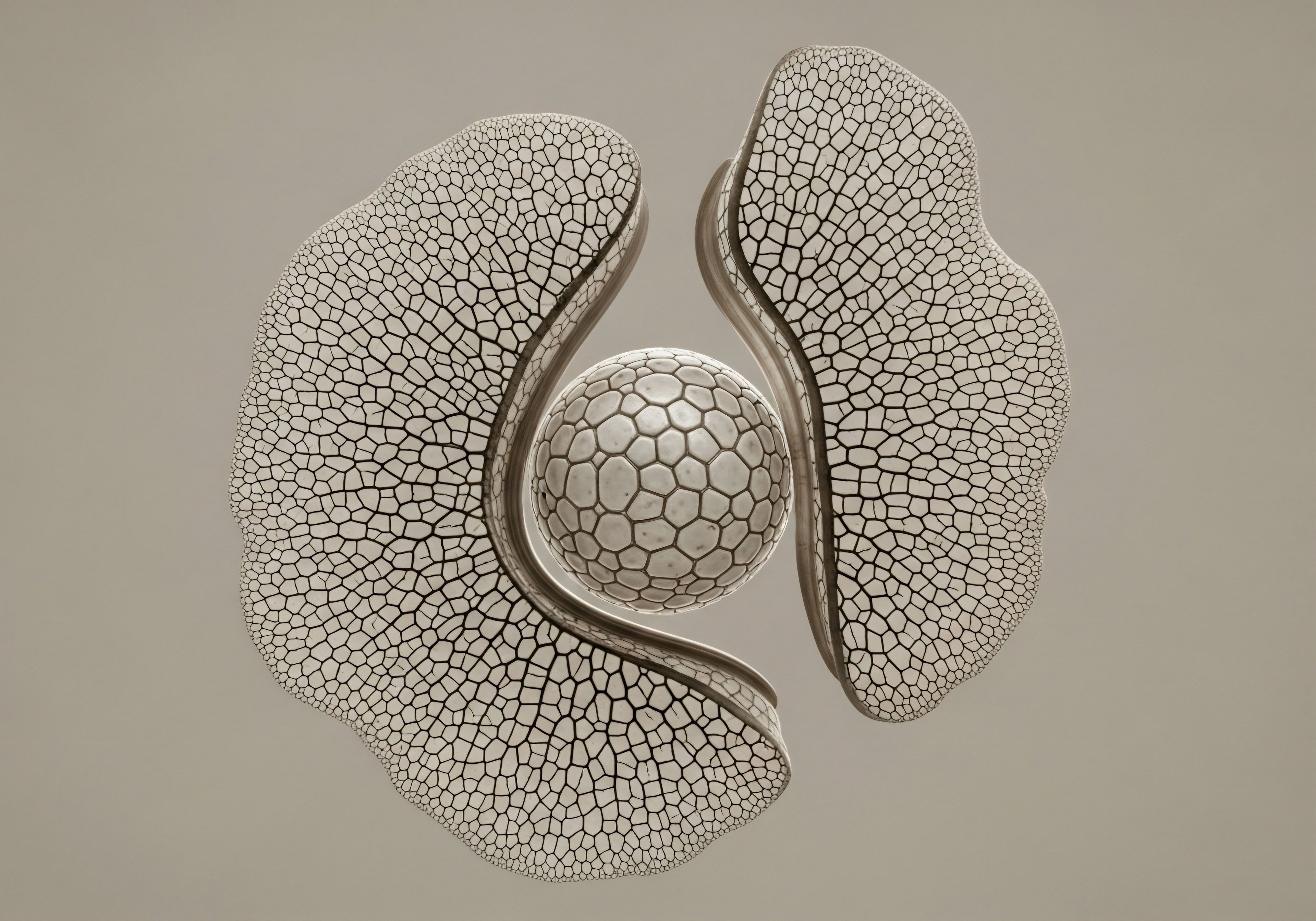

Fundamentals
The feeling is unmistakable. It is a subtle, persistent sense that your body’s internal calibration is off. Perhaps it manifests as a pervasive fatigue that sleep does not resolve, a mental fog that clouds focus, or a frustrating shift in your body’s composition despite consistent effort with diet and exercise.
This experience is a direct communication from your physiology, a signal that the intricate messaging system responsible for your vitality requires attention. Your body operates through a sophisticated network of hormones, which function as long-range chemical messengers, traveling through the bloodstream to instruct distant cells and organs. When you begin a protocol like Testosterone Replacement Therapy (TRT), you are fundamentally restoring the power and volume of one of the most important messengers in this network.
This is where peptides enter the conversation, acting as a different class of communicators. Peptides are short chains of amino acids, the building blocks of proteins, that function as highly specific, short-range signaling molecules. Think of them as local directors for cellular activity.
When used alongside an existing endocrine therapy, peptides introduce a layer of precision and refinement to the system. If TRT restores the foundational hormonal tone, peptides help to modulate the body’s response, ensuring that the restored hormones can be used with optimal efficiency. They work in concert with your body’s own biological intelligence, supporting the very systems that hormonal therapies influence.
Peptides act as precise signaling molecules that refine and support the body’s response to foundational endocrine therapies like TRT.

The Conductor and the Orchestra
To understand this relationship, it is helpful to use an analogy of a symphony orchestra. Endocrine therapies, such as administering testosterone, are akin to ensuring the entire brass section is present and playing with full force, providing the powerful, foundational sound of the orchestra. Without it, the music lacks depth and impact.
However, the richness of the symphony comes from the coordinated action of every section. Peptides function like the conductor’s specific cues to the string section, the woodwinds, or the percussion. They do not create the instruments; they guide the existing musicians to play with the right timing, rhythm, and intensity, resulting in a cohesive and powerful performance.
A key system they interact with is the Hypothalamic-Pituitary-Gonadal (HPG) axis. This is the command-and-control pathway for your sex hormones. The hypothalamus in your brain sends a signal to the pituitary gland, which in turn signals the gonads (testes or ovaries) to produce hormones like testosterone.
When you introduce testosterone from an external source, the brain senses that levels are adequate and reduces its own signals. Peptides can be used to communicate directly with this axis, helping to maintain the natural physiological pathways even while the body is receiving external support. This creates a more integrated and sustainable state of hormonal health, addressing both the foundational levels and the systems that regulate them.


Intermediate
As we move from foundational concepts to clinical application, the synergy between peptides and endocrine therapies becomes clearer. The goal of these integrated protocols is to create a robust and resilient hormonal environment. This is achieved by using peptides to support the body’s endogenous signaling pathways, which can be suppressed or altered by the introduction of exogenous hormones. The following protocols demonstrate how specific peptides are strategically combined with hormonal treatments to optimize outcomes for both men and women.

Synchronizing TRT in Men with HPG Axis Support
A standard protocol for men on Testosterone Replacement Therapy (TRT) often involves weekly intramuscular or subcutaneous injections of Testosterone Cypionate. This effectively restores serum testosterone to optimal levels, alleviating symptoms of hypogonadism like low energy, reduced libido, and diminished muscle mass.
A primary consequence of this therapy is the negative feedback it exerts on the Hypothalamic-Pituitary-Gonadal (HPG) axis. The brain’s hypothalamus detects high levels of testosterone and ceases its release of Gonadotropin-Releasing Hormone (GnRH). This, in turn, stops the pituitary gland from releasing Luteinizing Hormone (LH) and Follicle-Stimulating Hormone (FSH), the hormones that signal the testes to produce their own testosterone and maintain sperm production.
To counteract this, the peptide Gonadorelin is frequently incorporated into the protocol. Gonadorelin is a synthetic version of GnRH. By administering it, typically via subcutaneous injection twice a week, it directly stimulates the pituitary gland to release LH and FSH, bypassing the suppressed signal from the hypothalamus.
This action maintains testicular function, preventing the testicular atrophy commonly associated with TRT and preserving a degree of endogenous testosterone production. Additionally, an aromatase inhibitor like Anastrozole may be used to control the conversion of testosterone into estrogen, managing potential side effects and maintaining a balanced hormonal profile.
| Parameter | TRT Only Protocol | TRT with Gonadorelin Protocol |
|---|---|---|
| HPG Axis Signaling | Suppressed due to negative feedback from exogenous testosterone. | Endogenous signaling is suppressed, but pituitary is stimulated by Gonadorelin. |
| Testicular Function | Reduced function and potential for atrophy over time. | Function and size are better maintained. |
| Endogenous Testosterone | Production is significantly reduced or shut down. | A degree of natural production is preserved. |
| Fertility | Spermatogenesis is significantly impaired. | Fertility is better preserved. |

Integrating Growth Hormone Peptides for Systemic Benefits
Beyond maintaining the HPG axis, other peptides are used to amplify the systemic benefits of hormonal optimization. Growth Hormone Releasing Peptides (GHRPs) are a class of peptides that stimulate the pituitary gland to release Growth Hormone (GH). A common and effective combination is Ipamorelin and CJC-1295.
- Ipamorelin ∞ This is a GHRP that prompts a strong and clean pulse of GH release from the pituitary gland. It is selective, meaning it primarily affects GH levels without significantly impacting other hormones like cortisol.
- CJC-1295 ∞ This is a Growth Hormone Releasing Hormone (GHRH) analog. It extends the life of the GH pulse created by other secretagogues, leading to a more sustained elevation in GH levels.
When used with TRT, this peptide combination complements testosterone’s effects. While testosterone provides the anabolic signal for muscle growth, the elevated GH levels from the peptides enhance tissue repair, improve sleep quality, and accelerate fat metabolism. Patients often report deeper, more restorative sleep, faster recovery from workouts, and improved body composition. This dual approach addresses both anabolic signaling and the regenerative processes necessary for overall vitality.

What Is the Approach for Female Endocrine Health?
For women, particularly in the perimenopausal and postmenopausal stages, hormonal therapy is tailored to address a different set of physiological changes. Protocols may include low-dose Testosterone Cypionate to address symptoms like low libido, fatigue, and difficulty maintaining muscle mass. Progesterone is also a key component, prescribed to balance the effects of estrogen and support mood and sleep.
Peptides offer a valuable adjunctive role here as well. The same Ipamorelin/CJC-1295 combination can support the maintenance of lean body mass, improve skin elasticity by promoting collagen production, and enhance sleep quality, which is often disrupted during this life stage. The peptides work to amplify the benefits of the hormonal therapy, contributing to a more comprehensive improvement in well-being.


Academic
A sophisticated understanding of peptide and hormone integration requires a systems-biology perspective, examining the complex interplay between distinct but interconnected endocrine axes. The introduction of any therapeutic agent creates a cascade of adaptations throughout the body’s regulatory networks. Analyzing a specific peptide, Tesamorelin, and its influence on the somatotropic axis provides a clear example of this principle, particularly within the context of a patient already undergoing gonadal steroid therapy such as TRT.

The Molecular Dialogue of Tesamorelin and the Somatotropic Axis
Tesamorelin is a synthetic analogue of human growth hormone-releasing hormone (GHRH). Its primary mechanism of action is to bind to and stimulate GHRH receptors located on the somatotroph cells of the anterior pituitary gland. This stimulation mimics the endogenous pulsatile release of GHRH from the hypothalamus, triggering the synthesis and secretion of growth hormone (GH) into circulation. The therapeutic outcome is an augmentation of the natural, rhythmic peaks of GH secretion, which tend to decline with age.
This surge in circulating GH initiates a critical downstream effect ∞ it travels to the liver and other peripheral tissues, where it stimulates the production of Insulin-Like Growth Factor 1 (IGF-1). IGF-1 is the primary mediator of many of GH’s anabolic and metabolic effects, including cellular proliferation, tissue growth, and protein synthesis. Therefore, Tesamorelin therapy results in a sustained elevation of serum IGF-1 levels, which is a key biomarker for its therapeutic activity.
Tesamorelin, a GHRH analog, augments the body’s natural pulsatile secretion of growth hormone, subsequently increasing serum levels of the anabolic mediator IGF-1.

How Does This Influence Steroid Based Therapies?
When Tesamorelin is introduced into a system where an individual is receiving TRT, a multi-layered interaction occurs. The anabolic effects of testosterone are primarily mediated through the androgen receptor, promoting muscle protein synthesis. The elevated IGF-1 levels induced by Tesamorelin provide a powerful, complementary anabolic signal through a separate pathway, the IGF-1 receptor. This synergy can lead to more significant improvements in lean body mass and strength than either therapy could achieve alone.
There are also important metabolic considerations. GH is known to have a diabetogenic effect, promoting insulin resistance. Studies on Tesamorelin have shown that while it significantly increases IGF-1, its effects on glucose tolerance can be complex. Some research indicates that it may predispose individuals to glucose intolerance.
This is a critical point of interaction, as testosterone itself can improve insulin sensitivity in hypogonadal men. The net effect on a patient’s glucose metabolism is therefore a product of these opposing influences and must be carefully monitored through laboratory testing of markers like fasting glucose, insulin, and HbA1c. Furthermore, some evidence suggests that glucocorticoid metabolism can be altered by Tesamorelin, potentially reducing the efficacy of corticosteroids like cortisone or prednisone.
| Biomarker | Observed Effect of Tesamorelin | Clinical Implication |
|---|---|---|
| Growth Hormone (GH) | Increased pulsatile and mean concentrations. | Direct pharmacodynamic effect of the drug. |
| IGF-1 | Significant and sustained increase from baseline. | Primary mediator of anabolic effects; key monitoring parameter. |
| Fasting Glucose | Variable; potential for increase. | Requires monitoring for glucose intolerance or emergent diabetes. |
| Insulin Sensitivity | Potential for reduction. | Interaction with metabolic state and other therapies (e.g. testosterone). |

A Systems Biology Perspective on Integration
Viewing this from a systems biology framework, the combination of TRT and Tesamorelin represents a significant intervention at two primary nodes of the endocrine system ∞ the HPG axis and the GHRH-GH-IGF-1 axis. These axes are not isolated. They are linked through a web of cross-talk.
For example, sex steroids can influence GH secretion, and GH can influence metabolic parameters that affect steroid action. Administering both therapies simultaneously creates a new physiological state. The clinical imperative is to manage this new state with precision. This requires a deep understanding of the underlying mechanisms and a commitment to regular, comprehensive laboratory monitoring to ensure that the intended synergistic benefits are realized without pushing other related systems out of their optimal functional range.

References
- Stanley, T. L. Falutz, J. Marsolais, C. & Grinspoon, S. K. (2010). Effects of a Growth Hormone-Releasing Hormone Analog on Endogenous GH Pulsatility and Insulin Sensitivity in Healthy Men. The Journal of Clinical Endocrinology & Metabolism, 95(10), 4816 ∞ 4824.
- DrugBank Online. (n.d.). Tesamorelin ∞ Uses, Interactions, Mechanism of Action. Retrieved from DrugBank.
- Zhang, L. Cai, K. Wang, Y. Ji, W. Cheng, Z. Chen, G. & Liao, Z. (2019). The Pulsatile Gonadorelin Pump Induces Earlier Spermatogenesis Than Cyclical Gonadotropin Therapy in Men with Congenital Hypogonadotropic Hypogonadism. American Journal of Men’s Health, 13(1), 1557988318818280.
- Van Breda, E. Keizer, H. A. Kuipers, H. & Wolffenbuttel, B. H. (2003). Androgenic anabolic steroid use and severe hypothalamic-pituitary dysfunction ∞ a case study. International Journal of Sports Medicine, 24(3), 195 ∞ 196.
- Sinha, D. K. & Focht, W. J. (2021). Gonadorelin for Men on Testosterone Replacement Therapy (TRT). Rejenovate.
- Lau, J. L. & Dunn, M. K. (2018). Therapeutic peptides ∞ Historical perspectives, current development trends, and future directions. Bioorganic & Medicinal Chemistry, 26(10), 2700-2707.
- Bhasin, S. Yuan, Q. X. Steiner, B. S. & Swerdloff, R. S. (1987). Hormonal effects of gonadotropin-releasing hormone (GnRH) agonist in men ∞ effects of long-term treatment with GnRH agonist infusion and androgen. The Journal of Clinical Endocrinology & Metabolism, 65(3), 568-574.
- Fourman, L. T. & Grinspoon, S. K. (2020). Effects of tesamorelin on hepatic transcriptomic signatures in HIV-associated NAFLD. JCI Insight, 5(16), e140134.

Reflection

Calibrating Your Internal Systems
The information presented here provides a map of the intricate biological landscape that governs your health and vitality. Understanding how foundational therapies and precision signaling molecules interact is a powerful step in taking ownership of your physiological well-being. This knowledge transforms the conversation from one of simply treating symptoms to one of systematically recalibrating your body’s internal communication networks.
Each person’s system is unique, with its own history and its own specific needs for balance. Consider where your own journey has brought you. The path forward involves using this understanding as a tool for a deeper, more informed partnership with a clinical expert who can help translate these complex principles into a protocol that is singularly and precisely yours.



